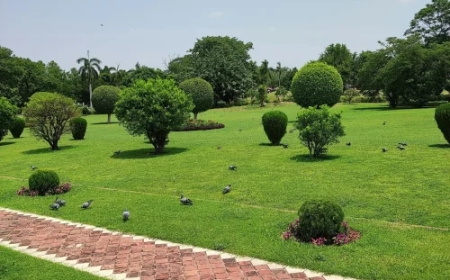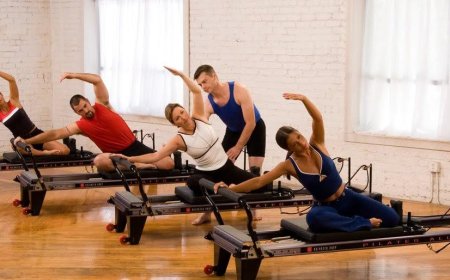Back Pain Relief at Home: Effective Exercises and Remedies
Back pain is a common issue that affects millions of people worldwide, often disrupting daily activities and diminishing quality of life.

Back pain is a common issue that affects millions of people worldwide, often disrupting daily activities and diminishing quality of life. Whether caused by poor posture, sedentary lifestyles, muscle strain, or underlying medical conditions, back pain can range from mild discomfort to debilitating agony. Fortunately, many cases of back pain can be managed or alleviated through simple home remedies, exercises, and lifestyle adjustments. This comprehensive guide explores effective strategies to relieve back pain at home, focusing on exercises, stretches, and practical tips to promote spinal health and overall well-being. With over 2200 words, this blog provides in-depth insights to help you take control of your back pain naturally.
Understanding Back Pain: Causes and Triggers
Before diving into remedies and exercises, its essential to understand the potential causes of back pain. Back pain can originate from various sources, including:
-
Muscle or Ligament Strain: Overexertion, heavy lifting, or sudden awkward movements can strain muscles or ligaments in the back.
-
Poor Posture: Slouching, improper sitting positions, or prolonged inactivity can stress the spine.
-
Sedentary Lifestyle: Lack of physical activity weakens core and back muscles, increasing vulnerability to pain.
-
Herniated or Bulging Discs: Discs that cushion the vertebrae may bulge or rupture, pressing on nerves.
-
Arthritis: Conditions like osteoarthritis can affect the spine, causing stiffness and discomfort.
-
Stress: Emotional stress can lead to muscle tension, particularly in the upper back and shoulders.
-
Medical Conditions: Issues like scoliosis, kidney infections, or sciatica may contribute to chronic pain.
Identifying the root cause of your back pain is crucial. If your pain is severe, persistent, or accompanied by symptoms like numbness, tingling, or fever, consult a healthcare professional to rule out serious conditions. For most cases of mild to moderate back pain, the following home-based approaches can provide significant relief.
The Importance of Movement for Back Pain Relief
While rest may seem like the best solution for back pain, prolonged inactivity can worsen symptoms by stiffening muscles and reducing flexibility. Gentle movement, through targeted exercises and stretches, strengthens the muscles supporting the spine, improves blood flow, and promotes healing. Regular physical activity also releases endorphins, the bodys natural painkillers, which can reduce discomfort.
Before starting any exercise program, ensure your movements are slow, controlled, and pain-free. If an exercise causes increased pain, stop immediately and consult a doctor or physical therapist. Below, we outline a series of effective exercises and stretches designed to alleviate back pain, improve flexibility, and strengthen the core and back muscles.
Warm-Up: Preparing Your Body
Before engaging in exercises, a brief warm-up is essential to loosen muscles and increase blood flow. A 510-minute warm-up can include:
-
Light Walking: Walk slowly around your home or in place to gently activate your muscles.
-
Shoulder Rolls: Roll your shoulders forward and backward to release tension in the upper back.
-
Gentle Twists: Stand with feet shoulder-width apart, and gently rotate your torso side to side, keeping movements small and controlled.
Effective Exercises for Back Pain Relief
The following exercises are designed to target key muscle groups that support the spine, including the core, glutes, and lower back. Perform these exercises 35 times per week for optimal results. Always listen to your body and avoid overexertion.
1. Cat-Cow Stretch
The Cat-Cow stretch is a gentle yoga-inspired movement that improves spinal flexibility and relieves tension in the back.
How to Do It:
-
Start on all fours with your hands under your shoulders and knees under your hips.
-
Inhale, arch your back (cow position), lifting your head and tailbone toward the ceiling.
-
Exhale, round your spine (cat position), tucking your chin to your chest and pulling your belly button toward your spine.
-
Repeat for 810 cycles, moving slowly with your breath.
Benefits: Enhances spinal mobility, stretches the back muscles, and promotes relaxation.
2. Childs Pose
This restorative yoga pose stretches the lower back, hips, and thighs, providing relief from tension.
How to Do It:
-
Kneel on the floor with your big toes touching and knees spread apart.
-
Sit back on your heels, then slowly lower your torso forward, resting it between your thighs.
-
Extend your arms forward or rest them by your sides, with your forehead touching the ground.
-
Hold for 3060 seconds, breathing deeply.
Benefits: Relaxes the lower back, reduces stress, and gently stretches the spine.
3. Pelvic Tilts
Pelvic tilts strengthen the lower back and core muscles, improving stability and reducing strain.
How to Do It:
-
Lie on your back with knees bent and feet flat on the floor, hip-width apart.
-
Tighten your abdominal muscles and gently press your lower back into the floor.
-
Hold for 5 seconds, then relax.
-
Repeat 1015 times.
Benefits: Strengthens the core, supports the lower spine, and improves posture.
4. Bridge Exercise
The bridge exercise targets the glutes, core, and lower back, promoting spinal stability.
How to Do It:
-
Lie on your back with knees bent, feet flat, and arms by your sides.
-
Engage your core and glutes, then lift your hips toward the ceiling until your body forms a straight line from shoulders to knees.
-
Hold for 510 seconds, then slowly lower your hips.
-
Repeat 1012 times.
Benefits: Strengthens the glutes and core, reduces lower back strain, and improves posture.
5. Bird Dog
This exercise enhances balance, strengthens the core, and stabilizes the spine.
How to Do It:
-
Start on all fours with a neutral spine.
-
Extend your right arm forward and left leg backward, keeping both parallel to the ground.
-
Hold for 5 seconds, engaging your core to maintain balance.
-
Return to the starting position and repeat with the left arm and right leg.
-
Perform 810 repetitions per side.
Benefits: Improves coordination, strengthens the core and lower back, and enhances spinal stability.
6. Seated Forward Fold
This stretch targets the hamstrings and lower back, relieving tightness.
How to Do It:
-
Sit on the floor with your legs extended straight in front of you.
-
Inhale, lengthen your spine, and exhale as you hinge at your hips to reach toward your toes.
-
Hold the stretch for 2030 seconds, keeping your back straight.
-
Repeat 23 times.
Benefits: Stretches the hamstrings and lower back, improving flexibility and reducing tension.
7. Supine Twist
This gentle twist relieves tension in the spine and promotes relaxation.
How to Do It:
-
Lie on your back with your legs extended.
-
Bring your right knee toward your chest, then guide it across your body to the left.
-
Extend your right arm out to the side and turn your head to the right.
-
Hold for 2030 seconds, then switch sides.
-
Repeat 23 times per side.
Benefits: Releases tension in the spine, improves mobility, and relaxes the back muscles.
Additional Home Remedies for Back Pain
In addition to exercises, several home remedies can complement your pain relief efforts. These strategies address inflammation, muscle tension, and overall comfort.
1. Apply Heat or Cold Therapy
-
Cold Therapy: For acute back pain or inflammation (e.g., after an injury), apply a cold pack wrapped in a towel to the affected area for 1520 minutes every 23 hours. This reduces swelling and numbs pain.
-
Heat Therapy: For chronic pain or muscle stiffness, use a heating pad or warm towel for 1520 minutes to relax muscles and improve blood flow.
Tip: Alternate between heat and cold for optimal relief, depending on the nature of your pain.
2. Maintain Proper Posture
Poor posture is a leading cause of back pain. Follow these tips to improve alignment:
-
Sit with your back straight, shoulders relaxed, and feet flat on the floor.
-
Use an ergonomic chair or lumbar support cushion when sitting for long periods.
-
Avoid slouching or hunching over devices.
-
When standing, distribute your weight evenly on both feet and engage your core.
3. Use Over-the-Counter Pain Relief
Nonsteroidal anti-inflammatory drugs (NSAIDs) like ibuprofen or acetaminophen can reduce pain and inflammation. Follow dosage instructions and consult a doctor if you need long-term use.
4. Try Foam Rolling
A foam roller can release muscle knots and improve flexibility. Roll gently over the affected area for 12 minutes, avoiding direct pressure on the spine.
5. Practice Stress Management
Stress can exacerbate back pain by causing muscle tension. Incorporate relaxation techniques such as:
-
Deep Breathing: Inhale deeply for 4 counts, hold for 4, and exhale for 6.
-
Meditation: Spend 510 minutes daily focusing on your breath or using a guided meditation app.
-
Gentle Yoga: Combine movement and mindfulness to reduce stress and improve flexibility.
6. Adjust Your Sleep Position
A proper sleep setup can prevent or alleviate back pain:
-
Sleep on a medium-firm mattress that supports your spines natural curve.
-
If you sleep on your back, place a pillow under your knees to reduce lower back strain.
-
If you sleep on your side, place a pillow between your knees to keep your spine aligned.
-
Avoid sleeping on your stomach, as it can strain your neck and back.
Lifestyle Changes to Prevent Back Pain
Preventing back pain requires long-term commitment to healthy habits. Incorporate these changes into your routine:
1. Stay Active
Regular physical activity strengthens the muscles that support your spine. Aim for at least 150 minutes of moderate aerobic exercise (e.g., walking, swimming) per week, combined with strength training and stretching.
2. Maintain a Healthy Weight
Excess weight, especially around the midsection, can strain the lower back. A balanced diet rich in fruits, vegetables, lean proteins, and whole grains, paired with regular exercise, can help maintain a healthy weight.
3. Strengthen Your Core
A strong core stabilizes the spine and reduces the risk of injury. Incorporate exercises like planks, side planks, and abdominal crunches into your routine.
4. Stay Hydrated
Proper hydration keeps spinal discs healthy and flexible. Aim for 810 glasses of water daily, adjusting based on activity level and climate.
5. Quit Smoking
Smoking reduces blood flow to the spine, slowing healing and increasing pain. Seek support to quit smoking if needed.
When to Seek Professional Help
While home remedies and exercises are effective for most cases of back pain, certain symptoms warrant medical attention:
-
Pain that persists beyond a few weeks.
-
Severe pain that doesnt improve with rest.
-
Pain radiating down the legs, especially below the knee.
-
Numbness, tingling, or weakness in the legs.
-
Unexplained weight loss, fever, or bowel/bladder issues.
A doctor or physical therapist can provide a tailored treatment plan, which may include imaging tests, medication, or physical therapy.
Creating a Daily Routine for Back Pain Relief
To maximize the benefits of these exercises and remedies, create a daily routine. Heres a sample schedule:
-
Morning: 5-minute warm-up + Cat-Cow Stretch and Pelvic Tilts (10 minutes total).
-
Midday: 10-minute walk + Childs Pose and Seated Forward Fold (10 minutes total).
-
Evening: Bridge Exercise, Bird Dog, and Supine Twist (15 minutes total).
-
Throughout the Day: Practice good posture, stay hydrated, and take short breaks to stretch if sitting for long periods.
Conclusion
Back pain doesnt have to control your life. By incorporating targeted exercises, home remedies, and lifestyle changes, you can alleviate discomfort, strengthen your body, and prevent future issues. Consistency is keymake these practices part of your daily routine to maintain a healthy, pain-free back. Always listen to your body, start slowly, and consult a healthcare professional if youre unsure about your condition. With dedication and the right approach, you can find relief and reclaim your mobility from the comfort of your home.
To Know Morel: ??? ??? ??? ?????? ????? ?????? ???? ????? ??????


































